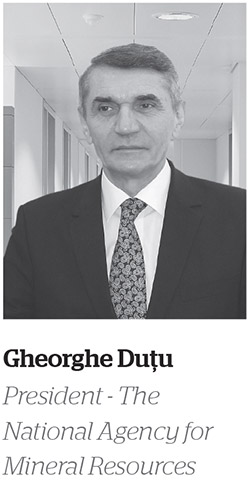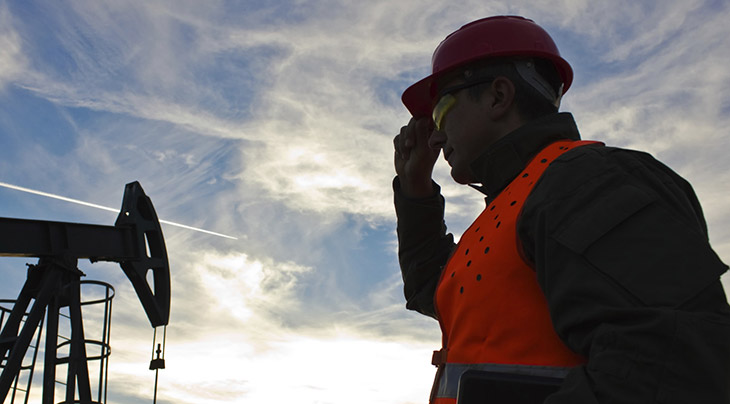The oil industry, but also the mining industry are characterized by continuous movement, Gheorghe Duțu, President of the National Agency for Mineral Resources, notices. On one hand, the Agency responds to these movements initiated by companies operating in the industry, on the other hand it monitors the developments and proposes new approaches. In the opinion of Gheorghe Duțu, the year 2014 confirms the important potential for the development of the oil sector. One of the support measures for the development of areas where oil operations are carried out would be to include the possibility that part of the royalties collected by the Romanian state from the execution of such works be distributed to the local communities.
 Mr. President, NAMR has as primary role boosting the rational capitalization of national mineral resources, by instructions and technical regulations. What is the direction you anticipate for such changes in the secondary legislation?
Mr. President, NAMR has as primary role boosting the rational capitalization of national mineral resources, by instructions and technical regulations. What is the direction you anticipate for such changes in the secondary legislation?
Continuing the rational capitalization of reserves owned by Romania is an objective constantly in our attention. In the area of natural resources, Romania currently benefits from a well-founded legal framework, in line with the European provisions in this field.
However, we should keep in mind that the oil and mining industries are characterized by a permanent movement. Therefore, it is important that, in the regulatory activity, the National Agency for Mineral Resources takes into account the current evolutions in the sector of natural resources and responds to the changing realities of the two industries. Therefore, during the development of NAMR activity, it resulted the need to implement certain amendments to the primary and secondary legislation in the field.
For example, in the oil industry, we noticed an increased specialization of holders of petroleum agreements and providers of related products and services, which is why, in 2013, we amended the Petroleum Law, in order to streamline operations in this segment.
The successful completion of the project of national interest regarding the interconnection of gas transmission systems of Romania and the Republic of Moldova, on Iaşi-Ungheni direction, is another aspect that would want to point out. Regarding this subject, I recall the amendments to the Petroleum Law, which aim at ensuring the legal framework of operation and functioning of pipelines interconnecting the gas transmission systems.
In July 2013 you stated in an interview: “It’s possible to distribute part of the royalties to local communities, which have perimeters where such projects are developed”. From what you currently know, is this element specified in the new form of the royalty system under preparation?
Currently, an inter-ministerial committee coordinated by the Ministry of Public Finance in Romania explores the opportunity to implement legal changes in the area of oil royalties. The purpose is to create proper balance between the revenues of the state and keeping an attractive framework for private investments.
The future royalty regime for hydrocarbons, suitable for Romania, will have as starting point the analysis of specific conditions of this sector in our country. Thus, among the coordinates considered, there’s also the possible diversification of the tax terms depending on the type and location of fields.
Of course, an important support for the development of areas where oil operations are carried out would be to include the possibility that part of the royalties collected by the Romanian state from the execution of such works be distributed to the local communities.
Please describe with some key-indicators the evolution of the oil sector in terms of NAMR responsibilities.
Currently, the National Agency for Mineral Resources has in progress petroleum agreements for 499 oil and gas fields, of which 274 active agreements with OMV Petrom, 141 active agreements with SNGN Romgaz SA Mediaș, 84 agreements with other holders. For a number of 52 petroleum agreements, the holders announced the intention of renunciation.
Oil production is almost entirely covered by OMV Petrom, by the exploitation of the 241 active fields, of which over 64 are in advanced stage of exploitation and will end in the following 5 years.
Regarding the situation of wells, data we have for this year indicate an important potential for the development of the oil sector.
In the offshore segment, I point out that works executed in the recent period by holders of petroleum agreements have highlighted several possible hydrocarbon-bearing geological structures. The preliminary results reconfirm the importance of continuing investments in the development of Romania’s oil sector. The discovery of new potential structures with hydrocarbon resources and reserves creates the possibility to replace the volumes annually consumed by exploitation and may have a positive impact in terms of securing Romania’s long-term access to oil resources.
When is it scheduled to start new public auctions for granting new concessions?
In the mining sector, the 88th Round has recently been carried out, which included a total of 24 exploration perimeters. Part of them aimed at activities of exploration of mineral energy resources (lignite, brown coal, geothermal waters). For 11 of the 24 perimeters offered in total, exploration licenses have been issued. In the case of 7 perimeters, there were no offers submitted, a number of 5 offers were disqualified during the auction procedure and for one of the perimeters auctioned an appeal was made.
For hydrocarbons, we consider for the following period the concession of an estimated number of 36 oil blocks for exploration, development and exploitation, both onshore and in the Black Sea basin.
The process of preparing the documentation for the XI Licensing Round is ongoing. I emphasize that the procedure of preparing the next round of bidding for oil blocks is carried out according to the legal provisions and there is no delay. So far, NAMR representatives have communicated in the public space the information regarding our intent to organize a new round. This message has been erroneously treated as the announcement regarding its official launch.
—————————————————-
The full version of this article can be read in printed edition of energynomics.ro Magazine, issued this November.
In order to receive the next issue (March 2015) of energynomics.ro Magazine for free, we encourage you to write us at office@energynomics.ro to include you in our distribution list.
